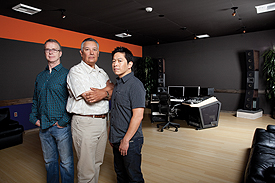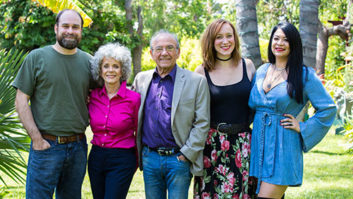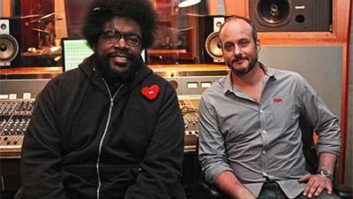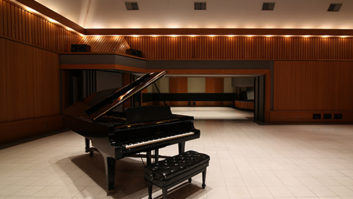
From left: Universal Mastering engineer Pete Doell, studio manager Nick Dofflemyer and Grammy-winning mastering engineer Erick Labsen in the spacious—and rectangular—Studio 2, with Lipinski monitors in the background
Photo: Hector Santizo
In the MixDecember 2009 issue, our former L.A. editor, Bud Scoppa, dropped in on Universal Mastering Studios West in the old Hanna-Barbera building on Cahuenga. What he described for the two main rooms—the sound, the physics, the dimensions—sounded simply too good to be true: a spacious, rectangular room, with a client-friendly producers couch and unlimited listening spot. For mastering?
So in anticipation of this month’s cover, UMSW Studio B, we flew down to Los Angeles for a listen with the Universal team and the facility designer, Hanson Hsu of Delta H Design Inc.
Avoiding the three main support beams in the core structure, Hsu proposed a doughnut model, with a central production space surrounded by administration and support offices. Studios A (32x21x11-foot ceiling) and B (28.5x21x11) form one side of a core, with high ceilings and floated floors. The other side houses five production rooms, where editors handle everything from quality assurance to sequencing of catalog material to the most robust metadata tagging that you might imagine from the world’s largest music company. It’s a space designed for workflow and critical listening, handling every format known to audio, with projects ranging from the 1930s to last week. It’s both high-volume and highly detailed.
“We wanted a client-friendly space, one that was large enough for people to spread out and still be able to make critical mastering decisions,” says director of studio operations Nick Dofflemyer. “We started with the type of work that the label needed. First, there is the restoration work—the removal of unwanted anomalies, the metadata tagging and the quality assurance. Then we have existing Universal and third-party label work for new material, both with clients and over the Internet. And finally, we’ve found a growing market in multitrack stem mixing/mastering for Guitar Hero and Rock Band [videogames]. That’s become big, and it’s one of the reasons why we built Studio A slightly larger.”
Once Hsu submitted his initial plans based on his proprietary Zero Reflection (ZR) Acoustics®, the proposal started moving up the Universal chain. Dofflemyer shepherded the process through legal and the executive committee, eventually getting sign-off from Vinnie Freda. Part of that process involved sending engineers and execs to listen to other ZR rooms around town. The final acceptance came once mastering engineers Pete Doell and Erick Labson, and technical engineer Ed Abbott, gave an enthusiastic nod to the ZR concept.
“The ZR theory came out of a studio we designed for Mike Shipley in 2003,” Hsu says. “Mike wanted to mix at home on an [Avid] ICON, but he didn’t want to give up space with angled walls, floated floors and a dropped ceiling. So we literally went back to the drawing board and looked at the reasons why bass builds up in the corners, for instance, and we simply removed those reasons.
“It’s applied physics, geometry and quasi-chaotic mathmatics. Any more details, and you have to sign an NDA,” he says, laughing.
During the next six years, Hsu built dozens of ZR rooms, each offering a generational change—not in the ZR principles, but rather with finessing and detail in the speaker interaction and room dimensions. He says that the concept works across all types of performance spaces and all sizes. UMSW is DHDI’s first mastering client.
“UMSW’s management made it clear they wanted no EQ in the room,” Hsu says. “Translation issues were critical, from the production rooms to the mastering rooms, and from the mastering rooms to the world at large, meaning other studios and the consumer. Once we got up and running, the reaction was, ‘How did you make three drastically different-sized rooms sound the same?’”
Studio B (pictured on the cover) is Labson’s home. A 19-year veteran of Universal, Labson took home a Grammy this year for a Little Walter box set on Chess. He makes use of a Dangerous Audio controller, SonicStudio 304 converter/cpu interface, SoundBlade DAW, and a lean but highly professional collection of outboard gear. After extensive listening tests, he settled on Lipinski 707A Signature Series monitoring, powered by Lipinski L-301V amps on the towers and L-300s on the subs.
Studio A is home to Pete Doell, who has been with Universal for six years and met Hsu when they were both over at Sony Pictures. He has the same workstation and monitor console, a similar collection of great processing gear, Pro Tools for mixing, Sonic Blade for mastering, and Dynaudio M3 monitors with custom amplication and cabling.
“The relationships we form are everything,” says Dofflemyer. “Erick has enormous skills and brings a level of trust with the client and a demeanor that instills confidence. Pete with six years of mastering and extensive background in tracking and mixing, brings a flexibility that is so important. Plus, he’s a musician and has a great sense of humor.”
“When we set out to do this, we asked ourselves, ‘What do these engineers need?’” concludes Hsu. “We decided the answer was to remove the room acoustics from the equation. Engineers have to translate content, transducers and room acoustics to achieve their final mix. We need to make their job easier so that they are completely free to listen to only content and transducers. No room. Zero Reflections. That’s what a ZR Acoustics® room does.”




